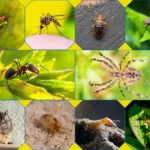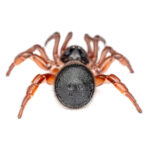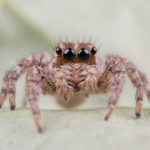In contrast to mammals, who lay eggs after becoming pregnant, spiders reproduce through a process known as mating. The female spider usually spins silk to form an egg sac in which she lays her eggs after mating. The silk aids in shielding the eggs from the elements and potential predators.
The pregnant female spider may protect the egg sac, and after laying the eggs, she may occasionally pass away. After emerging from the eggs, spiderlings go through several moults to become fully-grown spiders.
It’s crucial to remember that different spider species have different reproductive behaviours, and not all spiders use the same techniques. In this article, we will discuss pregnant spiders according to their classifications.
Table of contents
- Orb Weavers (Araneidae)
- Jumping Spiders (Salticidae)
- Wolf Spiders (Lycosidae)
- Tarantulas (Theraphosidae)
- Black Widows ( Latrodectus )
- Brown Recluses (Loxosceles)
- Hunting Spiders (Pisauridae)
- Crab Spiders (Thomisidae)
- Daddy Longlegs (Pholcidae)
- Trapdoor Spiders (Ctenizidae)
- Frequently Asked Questions (FAQs) about Pregnant Spiders
Orb Weavers (Araneidae)
Circular webs are characteristic of Orb-weaving spiders, which use them to ensnare their prey. Given below is the process that pregnant spiders of orb weaver species go through.

Mating
Orb weavers spiders get pregnant through mating. Usually, Orb-weaving spiders perform a mating ritual in which the male gives the female sperm. To transfer sperm to the female’s reproductive organs, the male may employ specialized structures on his pedipalps.

Egg Production
Upon successful mating, the orb-weaver female pregnant spider generates eggs. Within her reproductive system, the eggs develop. The spider is usually full of eggs in autumn.

Egg Sac Construction
When the eggs are ready, the pregnant spider creates an egg sac out of silk. The purpose of this sac is to shield the eggs from the elements and potential predators. The spider’s spinnerets, which are specialized structures located at the back of the abdomen, produce silk.

Egg Deposition
The eggs are laid by the female into the silk egg sac. Different species may lay different amounts of eggs.
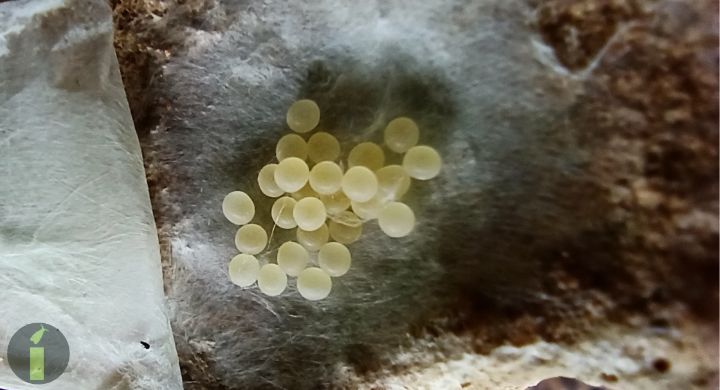
Guarding the eggs
The female may occasionally watch over the egg sac to keep predators away. But not every orb-weaving pregnant spider behaves in this way.

Spiderlings Hatch
The eggs inside the sac hatch into spiderlings after a set amount of time. The adult spider is represented in smaller form by the spiderlings.
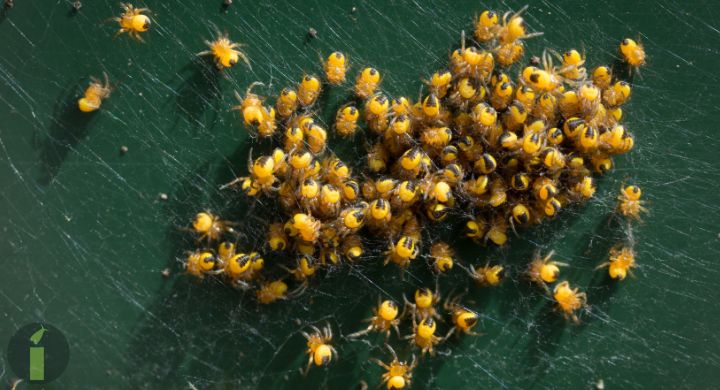
Jumping Spiders (Salticidae)
Jumping spiders have keen vision and can actively seek out their prey. Several species of jumping spiders have different reproductive processes, each with its own unique set of details.Jumping pregnant spiders’ during their pregnancies behave in the following ways:Jumping pregnant spiders’ during their pregnancies behave in the following ways:
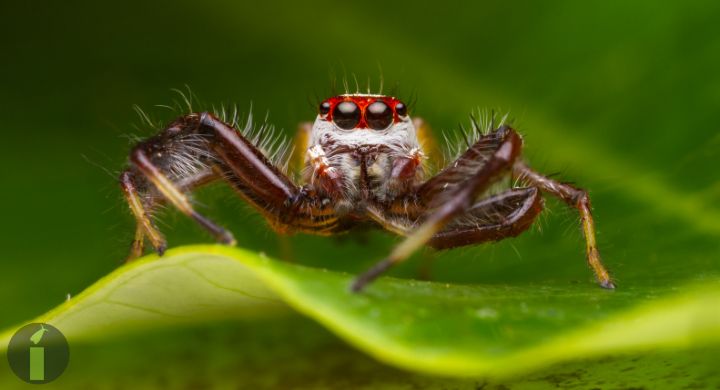
Mating
The intricate rituals involved in jumping spider courtship are well-known. To get the female’s attention, the male makes a variety of visual displays, frequently including movement and vibrations. The male approaches the female and mates with her if she is receptive.
Sperm Transfer
The male transfers sperm to the female’s reproductive organs using specialized structures called palps. Certain behaviours and signals may be involved in the complex mating process.
Egg Production
The female starts the egg-producing process after mating successfully. Within her reproductive system, the eggs develop.
Egg Sac Construction
When the eggs are ready, the pregnant spider creates an egg sac out of silk. Spinnerets are specialized structures found at the back of the abdomen that produce silk. The purpose of the egg sac is to shield the eggs from the elements and potential predators.
Egg Deposition
The eggs are laid by the female into the silk egg sac. Different species may lay different amounts of eggs.
Guarding the Eggs
The pregnant spider may occasionally stand guard over the egg sac to keep it safe from harm. But not every jumping spider behaves in this way.
Spiderlings Hatch
The eggs inside the sac hatch into spiderlings after a set amount of time. The adult spider is represented in smaller form by the spiderlings.
Wolf Spiders (Lycosidae)
Wolf spiders, like many other spiders, reproduce via a process known as sexual reproduction. Here/s how wolf pregnant spiders reproduce.

Mating and Courtship
To attract a female, male wolf spiders engage in courtship actions. This can include a variety of movements, vibrations, and, on occasion, the presentation of silk-wrapped prey. Mating happens after successful wooing, and the male transmits sperm to the female utilizing specialized structures known as pedipalps.
Egg Laying
The female wolf spider carries the fertilized eggs with her after mating, which are commonly attached to her spinnerets on the underside of her abdomen. The eggs are protected by a silken sac. The female pregnant spider may carry the egg sac with her as she moves and hunts.
Maternal Care
Wolf spiders are well-known for their parental instincts. The female pregnant spider protects the developing eggs by guarding the egg sac. The egg sac is carried by some wolf spider species linked to their spinnerets, while others may carry it in their jaws. The mother actively manages the environment around the egg sac, ensuring that the eggs develop in the best possible conditions.
Spiderling Emergence
When the eggs are ready to hatch, the female helps spiderlings emerge from the sac. The spiderlings clamber onto the mother’s abdomen and frequently remain there for an extended amount of time, getting some level of protection and, on occasion, sustenance. The spiderlings eventually disperse to live independent lives.
Tarantulas (Theraphosidae)
Tarantulas, belonging to the family Theraphosidae, reproduce through sexual reproduction, and the process is different from “pregnancy” in mammals. Instead of a gestation period inside the female’s body, tarantulas go through a series of stages that involve courtship, mating, egg-laying, and the development of spiderlings. Tarantula’s pregnant spider breeding process is as follows.

Courtship
To attract females, male tarantulas perform courtship behaviours. To converse with the female, you can drum on the substrate, vibrate, or use certain actions.
Mating
After successfully courting a female, the male transmits sperm to the female via specialized structures known as pedipalps. The female then stores the sperm until she is ready to use it.
Egg Laying
When a female is ready to lay eggs, she constructs a silk egg sac. She places the fertilized eggs in this sac and closes it. The growing eggs are protected by the egg sac.
Incubation
The egg sac is guarded by the pregnant spider, who often carries it with her or hides it in a safe place. She may be less active and more protective during this incubation time.
Spiderling Emergence
When the eggs hatch into spiderlings, they emerge from the egg sac. The pregnant spider may help the spiderlings emerge by opening the sac or coaxing them to exit.
Maternal Care
Some tarantula species demonstrate parental care, in which the mother actively protects and cares for the spiderlings after they hatch. In certain situations, the mother may even feed her children.
Black Widows (Latrodectus)
The term “pregnancy” does not apply to spiders, particularly black widows. Spiders, on the other hand, go through a reproduction process that includes courtship, mating, and egg-laying. Sexual reproduction is used by black widows in particular. Black widow’s pregnant spiders extend their families through the process given below:

Courtship
Male black widow spiders commence courtship by gently approaching a female. To avoid being mistaken for prey, they may engage in specialized actions such as vibrating their body or presenting silk-wrapped prey to the female.
Mating
Mating occurs after successful courtship. Male black widows use specialized structures called pedipalps to transmit sperm to females. The female retains the sperm in her reproductive system after mating until she decides to use it.
Egg Laying
When a female is ready to lay eggs, she makes a silk egg sac. As the eggs are placed into the sac, they are fertilized by the stored sperm. To preserve the eggs, the pregnant spider closes the sac.
Incubation
The female guards the egg sac, offering security and, on occasion, maternal care. Pregnant spider especially black widows are noted for being protective of their egg sacs and may turn aggressive if their young is threatened.
Spiderling Emergence
Spiderlings develop from the eggs within the sac after an incubation period. The mother may help with the emergence, but the spiderlings are normally left on their own to disperse.
Brown Recluses (Loxosceles)
Their cephalothorax is notable for having violin-shaped patterns. They are also poisonous. Brown recluse spiders (Loxosceles reclusa) go through the following reproductive cycle.

Courtship
Male brown recluse spiders commence courtship by gently approaching a female. They may communicate using precise movements and vibrations so that they don’t seem like a danger.
Mating
Mating occurs after a successful courtship. The male uses specialized structures called pedipalps to transmit sperm to the female. The sperm is stored by the female until she decides to deposit eggs.
Egg Laying
When a female is ready to lay eggs, she makes a silk egg sac. As the eggs are put into the sac, they are fertilized by the stored sperm. To preserve the eggs, the pregnant spider closes the sac.
Incubation
The female protects the developing eggs by guarding the egg sac. Because brown recluse spiders are more solitary and less parental than other spider species, this reduces the requirement of maternal care.
Spiderling Emergence
Spiderlings develop from the eggs within the sac after an incubation period. The mother may help with the emergence, after which the spiderlings scatter to begin their independent lives.
It is important to note that brown recluse spiders are are not good at maternal care as other spiders. When the spiderlings emerge, they usually fend themselves without the mother’s direct supervision. Furthermore, because brown recluse spiders are not aggressive and only bite when threatened, contact with people is uncommon.
Hunting Spiders (Pisauridae)
These spiders actively chase their prey and are frequently seen in aquatic environments. Pregnant spiders of Pisaurdae kind reproductive process are given below.

Courtship
To attract a female, male hunting spiders conduct courtship. This can include drumming on the substrate, delivering silk-wrapped prey, or performing specialized gestures to communicate with the female.
Mating
Mating occurs after successful courtship. The male uses specialized structures called pedipalps to transmit sperm to the female. The sperm is in the female’s spermatheca until she is ready to use it.
Egg Laying
When a female is ready to lay eggs, she makes a silk egg sac. The stored sperm fertilizes the the eggs in the sac. To protect the developing eggs, the mother closes the sac.
Incubation
The female may protect the developing eggs by guarding the egg sac. In some species, the female carries the egg sac and has links to her spinnerets.
Spiderling Emergence
Spiderlings develop from the eggs within the sac after an incubation period. The pregnant spider may help with the emergence, and the spiderlings usually disperse to start their own lives.
Pisaurid spiders, often known as nursery web spiders, have distinctive maternal care habits. The female weaves a silk nursery web into which she lays the egg sac. She helps the spiderlings emerge after they hatch and may give additional protection and aid during their early stages.
Crab Spiders (Thomisidae)
These spiders, named after their crab-like appearance, frequently wait in flowers to ambush their victim. Crab pregnant spiders go through the following reproduction process:

Courtship
Male crab spiders exhibit courtship rituals in order to attract a female. Visual displays, tactile communication, and the presentation of silk signals are examples of these activities.
Mating
Mating occurs after successful courtship. Male spiders use specialized appendages called pedipalps to transmit sperm to female spiders. The sperm is stored in the female’s spermatheca until she is ready to use it.
Egg Laying
When a female is ready to lay eggs, she makes a silk egg sac. The stored sperms fertilize the eggs in the sac. To protect the developing eggs, the mother closes the sac.
Incubation
The pregnant spider may protect the developing eggs by guarding the egg sac. Crab spiders, like many spiders, exhibit a variety of mother care behaviours, with the level of care varying between species.
Spiderling Emergence
Spiderlings develop from the eggs within the sac after an incubation period. The mother may help with the emergence, and the spiderlings usually disperse to start their own lives.
Crab spiders use hunting techniques, and they frequently ambush prey rather than weave webs. Thomisidae reproductive behaviours and maternal care differ by species, with some crab spiders exhibiting great maternal care while others exhibiting minimal involvement of the female in caring for the children.
Daddy Longlegs (Pholcidae)
cellar spiders have long slender legs and live in dark and damp areas. The following is a summary of the reproductive process in daddy longlegs.
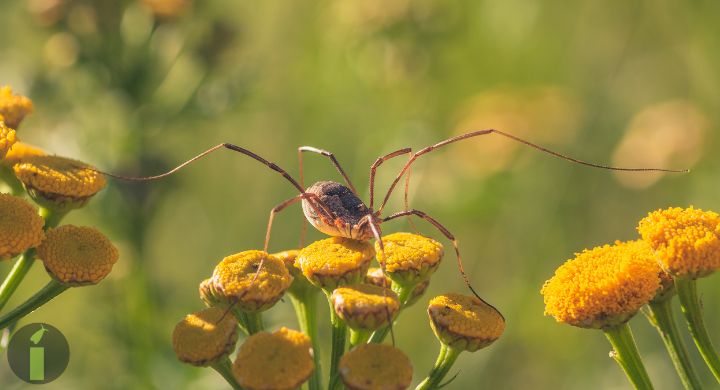
Courtship and Mating
To attract a female, male daddy longlegs engage in courtship practices. They do so by vibrating their bodies, tapping on the substrate, or displaying silk messages. Mating happens after successful courtship, and the male transmits sperm to the female utilizing specialized mechanisms.
Egg Laying
The female lays eggs after mating. Instead of making a typical silk egg sac, female Pholcidae lay their eggs in a mass and wrap them with silk. The stored sperm then fertilizes the eggs.
Maternal Care
Pregnant spiders of daddy longlegs type are are good at their parental care habits. The female guards the egg mass, who may hold it in her chelicerae (mouthparts) or attach it to her spinnerets. She will continue to protect the eggs until they hatch into spiderlings.
Spiderling Emergence
Spiderlings emerge from the egg mass once the eggs hatch. The mother may help with the process and continue to protect the spiderlings for a time. The spiderlings gradually spread to begin their own lives.
Trapdoor Spiders (Ctenizidae)
Create burrows with a silk and soil-hinged door. They ambush prey that approaches the entrance. Trapdoor spiders reproduce in a manner similar to that of other spiders. A pregnant spider of trapdoor type reproduces in the given manner:

Courtship and Mating
Male trapdoor spiders initiate courtship by approaching a female. Courtship behaviours may include drumming or other vibrations to signal their presence and intent. When courtship is successful, mating occurs, and the male transfers sperm to the female using specialized structures known as pedipalps.
Egg Laying
Female trapdoor spiders lay eggs after mating. Rather than building an egg sac like other spiders, she lays her eggs in a silk-lined chamber within her burrow. The pregnant spider uses silk to protect the eggs.
Maternal Care
Trapdoor spiders have very good parental instincts. When the eggs hatch, the pregnant spider protects them, as do the spiderlings. Some species may stay close to the burrow entrance or build a separate chamber for the eggs and spiderlings.
Spiderling Emergence
Spiderlings hatch from eggs after an incubation period. The mother may help them emerge, and the spiderlings usually stay close to the burrow for a while, receiving some maternal care. The spiderlings eventually spread to start their own lives.
Read More: A Complete Guide to Unveiling the Enthralling World of the Red House Spider
Frequently Asked Questions (FAQs) about Pregnant Spiders
Q1. How long is a female spider pregnant?
There are no pregnant spiders. Pregnancy implies that the spider is carrying eggs with developing embryos, which is never the case.
Q2. Do Spiders carry their babies?
Wolf spiders aren’t the only spiders that transport their egg sacs. Cellar spiders, the common spindly brown spiders that create cobwebs in dusty corners, hold their eggs in their jaws, which are loosely wrapping them. After hatching, these pregnant spiders will sometimes host their spiderlings in their web.
Q3. How do spiders give birth?
Pregnant spiders do not give birth to live babies; instead, they lay eggs. The eggs are held in a sac created by the mother from silken threads produced by spinnerets near the abdomen’s bottom. The threads are constructed of the same silk as spider webs, which are formed by liquid secretions that harden when they come into contact with the air.
Q4. Why do female spiders eat males after mating?
Females of several spider species consume their men after reproduction, either for sustenance or to keep their reproductive choices open, in a gruesome ritual known as sexual cannibalism. Female spiders are typically significantly larger than male spiders, giving them a significant physical advantage.


